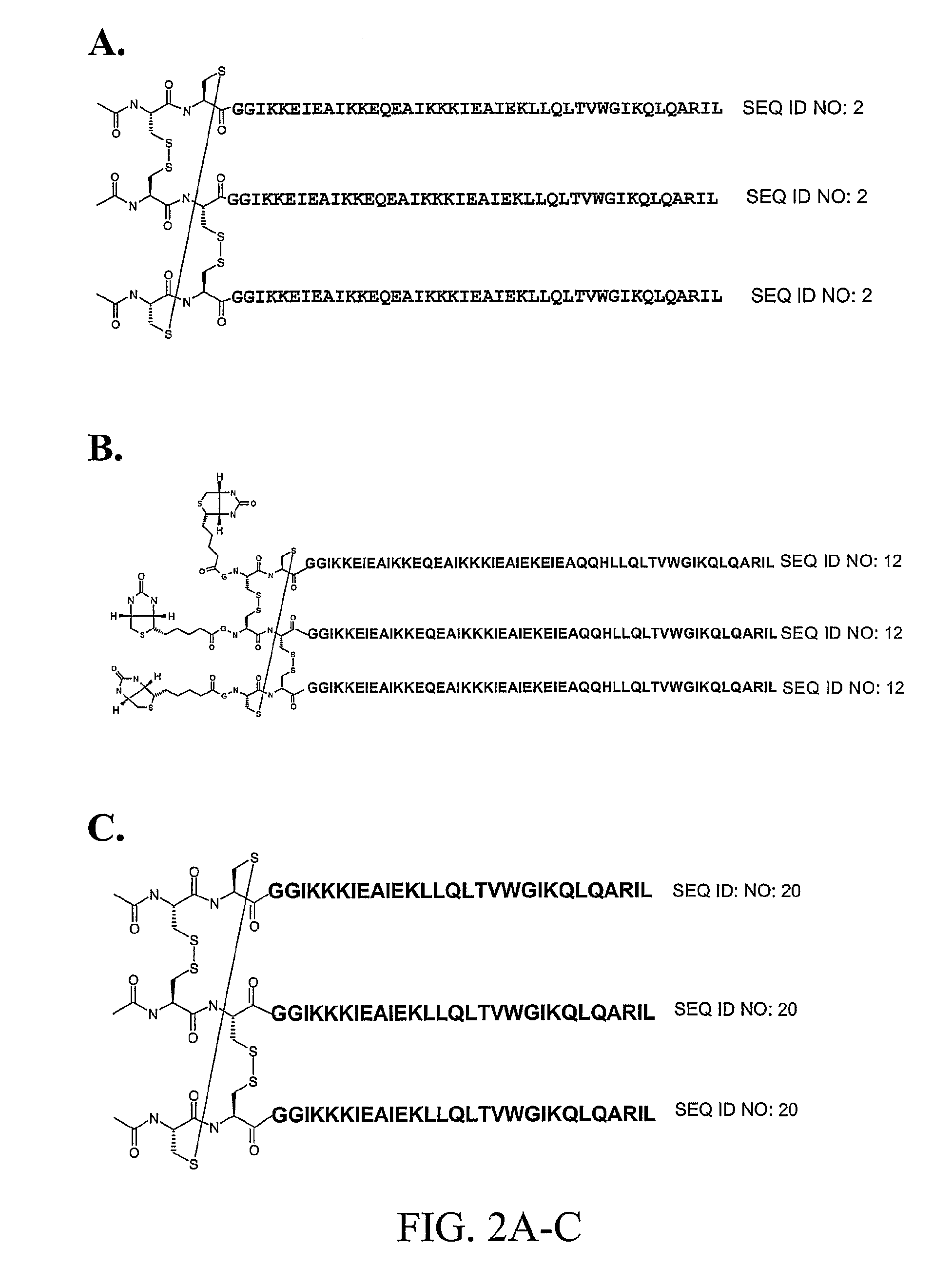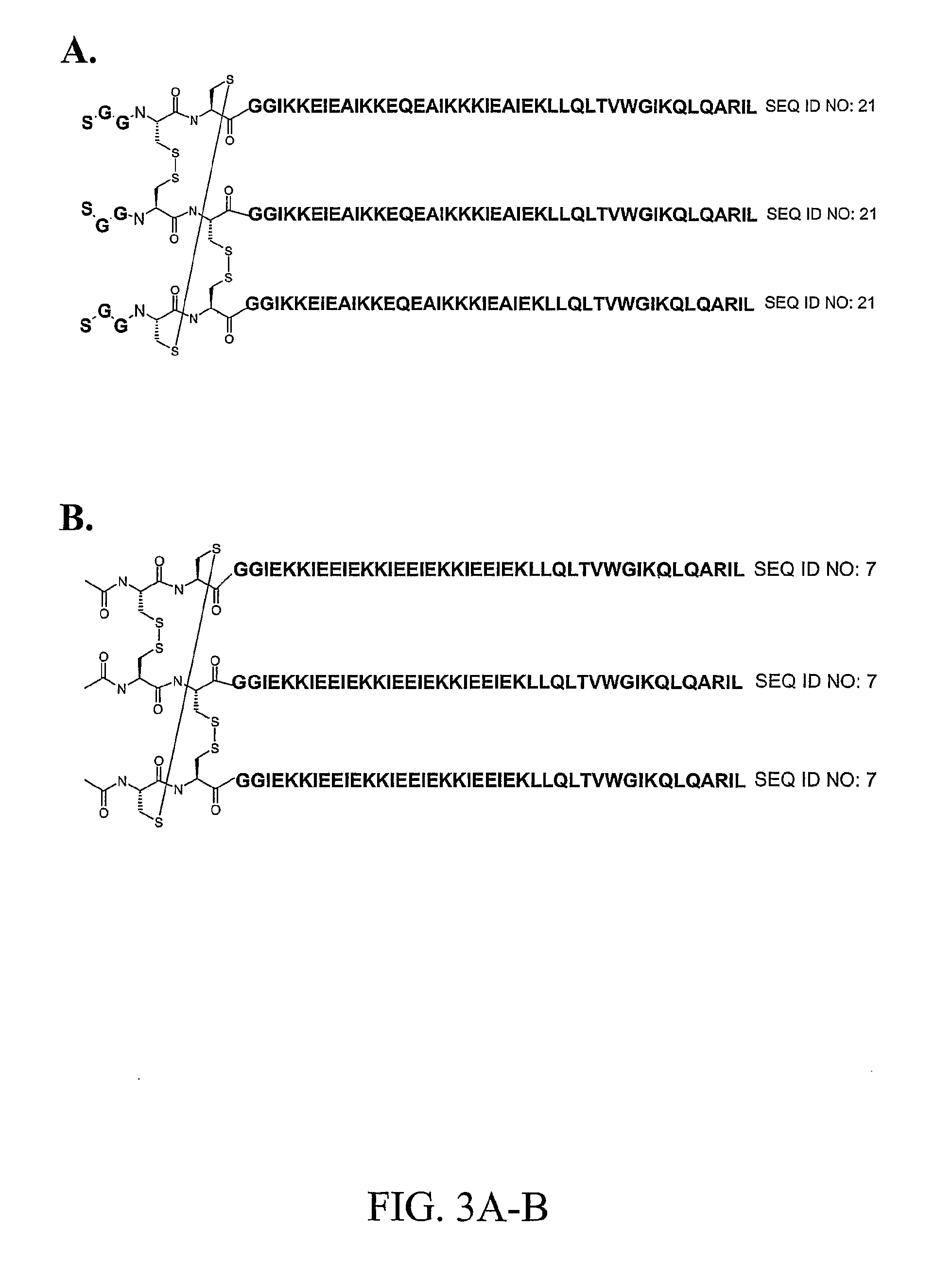Covalently stabilized chimeric coiled-coil HIV gp41 N-peptides with improved antiviral activity
a gp41 n-peptide, covalent stabilization technology, applied in the direction of peptides, drug compositions, immunological disorders, etc., to achieve the effect of inhibiting hiv infection of said cells, increasing immune responses, and preventing infection
- Summary
- Abstract
- Description
- Claims
- Application Information
AI Technical Summary
Benefits of technology
Problems solved by technology
Method used
Image
Examples
example 1
Peptide Synthesis and Covalent-Stabilization
[0132]Synthesis of IZN17 and CCIZN17—The peptides IZN17 (SEQ ID NO:1) and CCIZN17 (SEQ ID NO:2) were synthesized by solid phase using Fmoc / t-Bu chemistry on a Pioneer Peptide Synthesizer (Applied Biosystems). The resin used was the Fmoc-Linker AM-Champion, 1% cross-linked (Biosearch Technologies, Inc.), a PEG-PS based resin derivatized with a modified Rink linker p-[(R,S)-α-[9H-Fluoren-9-yl-methoxyformamido]-2,4-dimethoxybenzyl]-phenoxyacetic acid (Rink, H., 1987, Tetrahedron Lett. 28:3787-3789; Bernatowicz, M. S. et al., 1989, Tetrahedron Lett. 30:4645-4667). All the acylation reactions were performed for 60-120 minutes with 4-fold excess of activated amino acid over the resin free amino groups. Amino acids were activated with equimolar amounts of HBTU (2-(1H-benzotriazole-1-yl)-1,1,3,3-tetramethyluronium hexafluorophosphate) and a 2-fold molar excess of DIEA (N,N-diisopropylethylamine). The side chain protecting groups were as follows: t...
example 2
Preparation of Affinity Purification Resin with (SCCIZN17)3
[0146]Synthesis of SCCIZN17—SCCIZN17 (SEQ ID NO:21) was synthesized following the same protocols as outlined for the synthesis of IZN17 and CCIZN17 (see Example 1) except that the N-terminal serine (Ser) was left with the NH2-terminal free amine. The crude peptide (250 mg dissolved in 15 mL H2O / acetonitrile, 70 / 30, 0.1% TFA) was purified by gel permeation chromatography (GPC) on TSK-gel Toyopearl HW-50S resin (700×26 mm column), using 30% acetonitrile in water as eluent, 0.1% TFA, flow rate 1 mL / min. Analytical HPLC of eluted fractions was performed on a Beckman HPLC with a Phenomenex, Jupiter C4 column (150×4.6 mm, 5 μm) with the following gradient of eluent B (above): 35%-50% B (in 20 min)-80% (in 3 min), flow rate 1 ml / min. On the basis of the purity, the fractions were pooled and further purified by reverse phase HPLC with semi-preparative Waters RCM Delta-Pak™ C-4 cartridges (40×200 mm, 15 μm) using eluents (A) 0.1% TF...
example 3
Anti-Viral Activity of Covalently-Stabilized CC-Chimeric N-Peptides
[0150]Single-cycle HIV infectivity assay—HIV strains B2, BaL, 89.6, MN-1, and NL4-3 were purchased from Advanced Biotechnology Inc. (Bethesda, Md.). SHIV-89.6P (Reimann et al., 1996, J. Virol. 70:6922-6928) was obtained from N. Letvin (Beth Israel Hospital, Boston, Mass.) and passaged three times in human peripheral blood lymphocytes prior to use in the assay. HIV pseudotyped with the VSV-G protein was generated by transfecting 293T cells with the proviral DNA construct R8Δenv (Trono et al., 1989, Cell 59:113-120; Gallay et al., 1995, Cell 83:569-576) and pCMV-VSV-G (Wu et al., 1999, J. Virol. 73:2126-2135; gift of J. Kappes, University of Alabama Birmingham). P4-2 / R5 cells (Charneau et al., 1992, J. Virol. 66:2814-2820; Deng et al., 1996, Nature 381:661-666; gift of N. Landau, Salk Institute) are HeLa cells stably expressing human CD4 and CCR5 and harboring a β-galactosidase reporter gene driven by a tat-responsive ...
PUM
| Property | Measurement | Unit |
|---|---|---|
| molecular weight | aaaaa | aaaaa |
| molecular weight | aaaaa | aaaaa |
| molecular weight | aaaaa | aaaaa |
Abstract
Description
Claims
Application Information
 Login to View More
Login to View More - R&D
- Intellectual Property
- Life Sciences
- Materials
- Tech Scout
- Unparalleled Data Quality
- Higher Quality Content
- 60% Fewer Hallucinations
Browse by: Latest US Patents, China's latest patents, Technical Efficacy Thesaurus, Application Domain, Technology Topic, Popular Technical Reports.
© 2025 PatSnap. All rights reserved.Legal|Privacy policy|Modern Slavery Act Transparency Statement|Sitemap|About US| Contact US: help@patsnap.com



